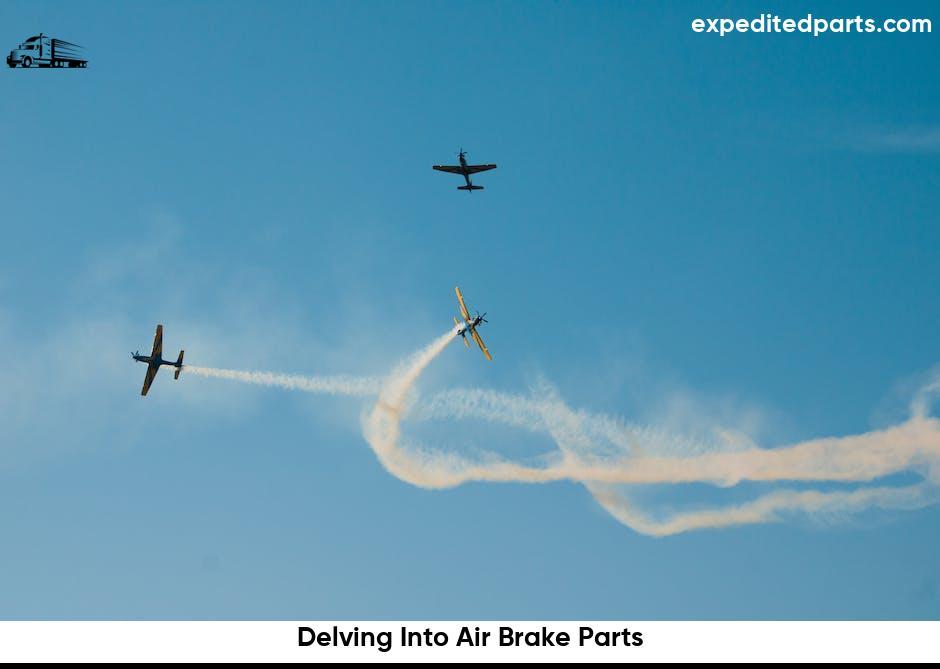Ready to dive deep into the world of air brake parts? Explore the anatomy, functionality, and maintenance tips of these essential components. Let’s go!”
When it comes to understanding the intricate workings of air brake systems, delving into air brake parts is essential. Air brake systems are widely used in heavy vehicles such as trucks, buses, and trains to ensure safe and efficient braking. These systems rely on a complex network of components, including air compressors, brake chambers, valves, and hoses, all working in harmony to convert air pressure into mechanical force. Delving into air brake parts allows us to gain a comprehensive understanding of their functions and importance in maintaining the safety and reliability of these vehicles. By exploring the intricacies of these components, we can better grasp the inner workings of air brake systems and appreciate their vital role in the transportation industry.
The Essential Guide to Understanding Air Brake Parts
The Essential Guide to Understanding Air Brake Parts is a comprehensive resource that will provide you with a thorough understanding of the various components that make up an air brake system. Whether you are a truck driver, mechanic, or simply interested in learning about how air brakes work, this guide is for you.
- Air compressor: This component is responsible for pressurizing the air used in the brake system.
- Air reservoirs: These tanks store the pressurized air and supply it to the brake chambers.
- Brake chambers: These chambers convert the pressurized air into mechanical force to apply the brakes.
- Brake valves: These valves control the flow of air and allow for smooth and precise brake application.
- Brake shoes and drums: These components create friction to slow down or stop the vehicle.
- Slack adjusters: These devices ensure the proper tension of the brake shoes against the drums.
By understanding the function and importance of each air brake part, you will be better equipped to diagnose and address any issues that may arise. Additionally, this knowledge will contribute to safer driving and efficient maintenance of your air brake system.
Uncovering the Secrets of Air Brake Parts: A Comprehensive Overview
| Part | Description |
|---|---|
| Air compressor | This component pressurizes the air supply used in the brake system. |
| Air reservoirs | These tanks store the pressurized air and act as a reservoir for supplying air to the brake chambers. |
| Brake chambers | These chambers convert the pressurized air into mechanical force to engage the brakes. |
| Brake valves | These valves control the flow of air and regulate brake application with precision. |
| Brake shoes and drums | These components create friction to slow down or stop the vehicle. |
| Slack adjusters | These devices maintain the proper tension of the brake shoes against the drums for optimal performance. |
With the comprehensive overview of air brake parts provided in this guide, you will gain a deeper understanding of how each component contributes to the overall functionality and safety of the braking system. Whether you are looking to troubleshoot issues or enhance your knowledge, this resource will be invaluable.
Air Brake Parts: Everything You Need to Know
When it comes to ensuring safe and reliable braking in vehicles, air brake systems play a vital role. Understanding the different components of air brake systems and their functions is crucial for drivers, mechanics, and anyone involved in the transportation industry. In this comprehensive guide, we will walk you through everything you need to know about air brake parts.
One way to categorize air brake parts is by their position in the system. Let’s take a look at the key components:
| Component | Function |
|---|---|
| Air Compressor | Generates compressed air to power the brake system |
| Air Reservoir | Stores compressed air for immediate use |
| Air Dryer | Removes moisture from the compressed air to prevent system failures |
| Brake Pedal | Controls the operation of the brake system |
| Brake Chambers | Converts air pressure into mechanical force to engage the brakes |
| Slack Adjusters | Regulates the distance between brake shoes and drums for optimum braking performance |
| Brake Shoes | Apply friction to the brake drums to slow down or stop the vehicle |
These are just a few of the essential air brake parts that make up a complete system. Each component plays a crucial role in ensuring effective braking and safe operation. It is important to regularly inspect, maintain, and replace these parts to keep the air brake system functioning optimally.
By familiarizing yourself with the different air brake parts and their functions, you can better understand how the brake system operates. This knowledge can help you troubleshoot issues, perform routine maintenance, and ensure the safety of yourself and others on the road.
Mastering the Art of Air Brake Parts: A Step-by-Step Guide
Step 1: Understanding the Basics
- Gain a solid understanding of the fundamentals of air brake systems and their components.
- Learn about the different types of air brake systems used in various vehicles.
Step 2: Identify the Components
- Familiarize yourself with the key air brake parts, like the air compressor, air reservoir, brake pedal, brake chambers, slack adjusters, and brake shoes.
- Understand the function of each component and how they work together to provide effective braking.
Step 3: Learn Maintenance and Troubleshooting
- Discover the best practices for inspecting, maintaining, and replacing air brake parts.
- Develop troubleshooting skills to identify and resolve common issues in air brake systems.
- Practice assembling and disassembling air brake components to develop proficiency.
Step 5: Continuous Learning
- Stay updated with the latest advancements and regulations in the field of air brake systems.
- Participate in training programs and workshops to enhance your knowledge and skills.
The Ultimate Air Brake Parts Handbook: All You Need to Get Started
Are you interested in learning about air brake parts and how they work? Look no further! The Ultimate Air Brake Parts Handbook is here to guide you through everything you need to know to get started.
- This handbook provides a comprehensive overview of all the essential air brake parts and their functions.
- Learn about the different types of air brake systems and how they operate.
- Discover the key components of an air brake system, such as the compressor, governor, valves, and brake chambers.
- Understand the importance of proper maintenance and inspection of air brake parts for optimal performance and safety.
- Find practical tips and advice on troubleshooting common issues with air brake systems.
- Gain confidence in your knowledge of air brake parts and feel empowered to handle any air brake-related challenges.
Demystifying Air Brake Parts: A Deep Dive into the Mechanics
Have you ever wondered how air brake parts work and what makes them so essential in the world of transportation? Demystifying Air Brake Parts is your ultimate guide to understanding the mechanics behind these crucial components.
| s Covered | Highlights |
|---|---|
| The basic principles of air brake systems | Gain a solid foundation in the fundamental concepts |
| The role of air compressors and governors | Discover how these components regulate the air pressure |
| The different types of air brake valves and their functions | Understand how valves control the flow of air |
| The inner workings of brake chambers | |
| The importance of air brake maintenance and inspection | Learn how to ensure optimal performance and safety |
Whether you are a curious enthusiast or a professional working with air brake parts, this guide will equip you with the knowledge and confidence to navigate the world of air brake mechanics with ease. Get ready to demystify the inner workings of air brake parts and elevate your understanding to new heights!
The Hidden Gems of Air Brake Parts: Lesser-Known Facts Revealed
When it comes to air brake parts, there are often some hidden gems that many people are not aware of. These lesser-known facts can shed light on the importance and effectiveness of these crucial components in maintaining optimal performance and safety in vehicles. Here are some key points to know about air brake parts:
1. Air Compressor: The heart of the air brake system, the air compressor is responsible for pressurizing the air that is used for brake operation. It pumps air into the system and ensures a consistent and reliable source of compressed air.
4. Brake Drums and Shoes: The brake drums, usually made of cast iron, provide a surface for the brake shoes to press against, creating friction and stopping the vehicle. The brake shoes, typically lined with heat-resistant material, apply pressure to the drums to slow down or stop the vehicle.
5. Air Dryers: These components play a crucial role in removing moisture from the compressed air system. Moisture can lead to corrosion and reduce the efficiency of the brakes. Air dryers help prevent moisture buildup, ensuring reliable brake performance.
7. Brake Fluid: Although air brakes primarily use compressed air, brake fluid is still involved in some components, such as the hydraulic portion of the brake system. It serves as a medium for transmitting force and pressure between the brake pedal and the brake chambers.
By understanding these hidden gems of air brake parts, you can appreciate the vital role they play in the overall functioning of the braking system. Regular maintenance, proper adjustment, and choosing high-quality components are essential for optimal performance and safety on the road.
Unlocking the Power of Air Brake Parts: Tips and Tricks for Optimal Performance
To ensure optimal performance of air brake parts, it’s essential to unlock their full potential. Here are some tips and tricks that can help you make the most of your air brake system:
1. Regular Inspection and Maintenance: Conduct routine inspections to check for any signs of wear or damage. Replace worn-out components promptly to prevent further damage or brake failure. Regularly clean and lubricate moving parts to ensure smooth operation.
2. Check Air Pressure: Proper air pressure is crucial for the efficient functioning of the air brake system. Regularly check air pressure levels and ensure they are within the recommended range. Low air pressure can lead to decreased braking power, while high pressure can cause damage to the system.
6. Driver Training: Proper training for drivers on air brake system operation is crucial. Ensure drivers understand the correct procedures for engaging and disengaging the brakes, as well as the importance of regular inspections and maintenance. This knowledge will enable drivers to operate the system efficiently and detect any signs of potential issues.
By implementing these tips and tricks, you can unlock the full power of your air brake parts and maintain optimal performance. Remember, proper maintenance, monitoring, and driver training are key to ensuring the safety and reliability of your braking system.
Here are some essential points to keep in mind:
1. Brake Chamber: This component is responsible for converting the air pressure into mechanical force, enabling the braking action. It consists of a diaphragm that pushes against a pushrod, applying pressure to the brake shoes or pads.
2. Slack Adjuster: The slack adjuster is the linkage between the brake chamber and the brake shoes. It ensures that the brake shoes maintain the proper distance from the drum or disc, enabling effective braking.
3. Air Compressor: The air compressor is at the heart of the air brake system. It compresses air into the reservoirs, providing the necessary pressure for brake operation. Regular maintenance and inspection of the air compressor are crucial to ensure optimal performance.
4. Brake Drum/Disc: The brake drum or disc is an essential part of the braking system. When pressure is applied, the brake shoes or pads make contact with the drum or disc, creating the friction needed to slow down or stop the vehicle.
5. Air Reservoirs: The air reservoirs store compressed air from the air compressor. They act as a source of pressure for the braking system, ensuring consistent and reliable brake operation. Regular inspection and maintenance of the reservoirs are necessary to avoid air leaks and maintain proper pressure levels.
6. Valves and Lines: Various valves and lines connect the different components of the air brake system. These valves control the flow of compressed air and enable smooth operation. Regular inspection and maintenance of valves and lines are essential to ensure proper functionality and prevent air leaks.
7. Air Dryer: The air dryer removes moisture from the compressed air, preventing water droplets from entering the brake system. Moisture can cause corrosion and damage to the components, leading to brake failure. Regular maintenance and replacement of the air dryer cartridge are necessary to ensure optimal performance.
Here are some key points to assist you on this journey:
1. Familiarize Yourself with Basic Components: Start by learning about the fundamental components of an air brake system, such as the brake chamber, slack adjuster, air compressor, brake drum/disc, air reservoirs, valves, and lines. Understand their functions and how they work together to ensure effective braking.
2. Study System Operation: Gain a comprehensive understanding of how the air brake system operates. Learn about the pressure generation, storage, and distribution processes. Understand the sequence of events that occur when you apply the brakes and how the components interact to facilitate braking.
3. Learn about Maintenance and Troubleshooting: Regular maintenance is crucial to ensure the optimal performance and safety of air brake systems. Study the maintenance procedures recommended by manufacturers and familiarize yourself with troubleshooting techniques to identify and rectify potential issues.
4. Stay Updated with Regulatory Requirements: Stay informed about the regulations and standards governing air brake systems. Different regions may have specific requirements regarding brake components, installation, and maintenance. By adhering to these regulations, you can ensure compliance and promote safety.
For detailed information, you can contact us: Torque


